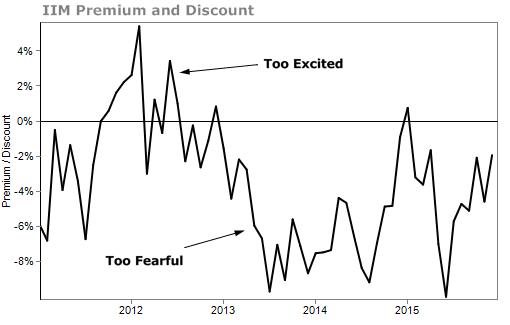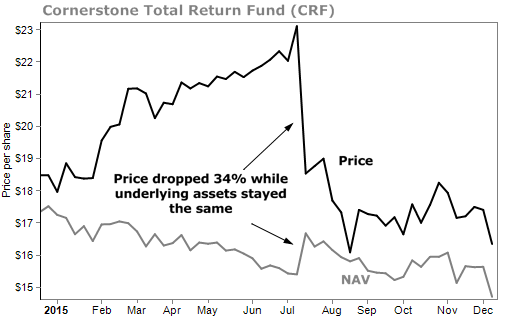It's advice I've given time and time again...
Whether it's a diagnosis from a doctor, a mechanic's repair estimate, or a health warning from the Centers for Disease Control and Prevention (CDC), you should never blindly trust anyone.
It's advice that has worked since former president Ronald Reagan made it famous during the Cold War... "Trust, but verify."
I even tell my research team to verify things I tell them. That's why they spend hours – and even days – substantiating our articles.
So I love when subscribers question our topics... Today, I explain why it's important to buy closed-end funds trading for a discount, the risks of changing your water heater's temperature, and how to store water for any emergency.
Think we need to explain ourselves? Send your questions to [email protected].
Q: Obviously, it makes perfect sense to buy a closed-end fund when it's trading at a discount instead of at a premium, but where or when does this benefit me, the investor? I don't recall reading that closed-end funds have a higher average return than other similar investments, which they should if the purchase discount were to return to my bottom line.
Conversely, if I buy a fund selling at a premium, does that mean that down the road I will have less return?
Maybe I'm missing the obvious and the answer is that it's always better to buy something at a discount? – R.T.
A: Closed-end funds issue a limited number of shares. So the share price can fluctuate based on investor demand. This means that a closed-end fund can trade above ("at a premium") or below ("at a discount") the value of the fund's assets – called the net asset value (NAV).
I prefer to invest in funds that are trading at a discount to NAV because it's like spending a dollar and getting more than a dollar's worth of assets.
But this question is a smart question.
After all, just because the fund is trading at a discount today, how does that make us money? How do we know that it will trade for fair value in the future?
Funds can decide to buy back shares – just like companies do – to correct the imbalance and make the price rise. But that doesn't happen very often.
Rather, we look at the discount (or premium) on a fund as a measure of sentiment. Sentiment measures how investors feel about a particular asset. Sometimes they can be very wrong.
Look at the premium and discount of the Invesco Value Municipal Income Fund (IIM) over the last five years.
There are times when investors get excited and buy up this fund... and other times when they ditch it due to fear. If you buy when they are fearful, the fund tends to rise when investors start acting more normally.
Or look at the Cornerstone Total Return Fund (CRF) over the last year. Investors used to love it, and paid an outrageous near-50% premium at one time. Then they changed their minds and the fund's price tanked... even though the underlying investment barely moved.
There's no guarantee that a closed-end fund's price will trade back up to its NAV, but they do tend to do so over time. Buying cheap funds gives you a good opportunity for a return. Avoiding expensive ones can keep you safe.
Q: Lowering domestic hot water tank temperature may be good for the wallet, but can turn out to be harmful to user's health. 140°F set point is used to lower risk of Legionella contamination. – M.A.
A: As the Department of Energy points out, lowering your water heater's temperature to 120°F is considered safe for the general public.
As it turns out, the Legionella bacteria only infects about 2%-5% of people exposed to the bacteria. Those people most at risk are people with compromised immune systems, the elderly, and those with any respiratory difficulties. These folks should keep their tanks at about 140°F.
Another thing to keep in mind is the kind of hot water heater you have. One study published in the Canadian Journal of Infectious Diseases & Medical Microbiology checked out the growth of Legionella in homes across Quebec. Researchers found that the electric tanks they checked did not have even temperature distribution – meaning if you turned the temperature to 120°F, the bottom of the tank might actually be closer to 100°. Of the 178 electric water heaters they checked, 40 had Legionella growth. None of the oil or gas heaters did.
So when considering how much to lower your temperature, take these two things into consideration:
- Is anyone in the home at increased risk of contracting the bacteria?
- What type of water heater do you have?
The Canadian study pointed out that 131°F is hot enough to clear out the bacteria, so if you're a bit nervous, try turning the temperature down just a few degrees. It'll still help shave off a few dollars every month from your energy bill.
[optin_form id="286"]
Q: Can you suggest the way in which you would recommend one store water in an emergency? One gallon containers, five gallon, or what? – B.G.
A: Last month, when Winter Storm Jonas hit the East Coast, hundreds of thousands of people lost power. And many people – including some of my colleagues – were stuck in their homes for several days after the storm ended. It's a reminder that you should always be prepared for a disaster. And having access to water is essential.
Five-gallon "water cooler" jugs may be the easiest and most economical way to stock up. One-gallon jugs may fit better into available shelving. What's important is having enough for each person. As I mention in the issue called "Nine Ways to Stay Safe From a Disaster This Winter," you should have at least one gallon of water per person per day.
And be careful where you store it. Most people don't realize storing plastic water bottles on concrete can start a chemical reaction and contaminate the water. Don't put plastic containers directly on cement floors. To be safe, store them on plywood or another nonporous membrane.
What We're Reading...
- Learn how to safely store water for the long term.
- Something different: This one-hour security drill will keep you from being hacker bait.


